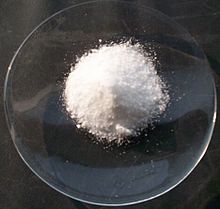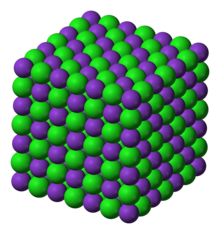
Back Kaliumchloried Afrikaans كلوريد البوتاسيوم Arabic Калиялъул хлорид AV پوتاسیوم کولورید AZB Хларыд калію Byelorussian Калиев хлорид Bulgarian পটাশিয়াম ক্লোরাইড Bengali/Bangla Kalij-hlorid BS Clorur de potassi Catalan Chlorid draselný Czech
 | |
 | |
| Names | |
|---|---|
Other names
| |
| Identifiers | |
3D model (JSmol)
|
|
| ChEBI | |
| ChEMBL | |
| ChemSpider | |
| DrugBank | |
| ECHA InfoCard | 100.028.374 |
| E number | E508 (acidity regulators, ...) |
| KEGG | |
PubChem CID
|
|
| RTECS number |
|
| UNII | |
CompTox Dashboard (EPA)
|
|
| |
| |
| Properties | |
| KCl | |
| Molar mass | 74.555 g·mol−1 |
| Appearance | white crystalline solid |
| Odor | odorless |
| Density | 1.984 g/cm3 |
| Melting point | 770 °C (1,420 °F; 1,040 K) |
| Boiling point | 1,420 °C (2,590 °F; 1,690 K) |
| 27.77 g/100mL (0 °C) 33.97 g/100mL (20 °C) 54.02 g/100mL (100 °C) | |
| Solubility | Soluble in glycerol, alkalies Slightly soluble in alcohol Insoluble in ether[1] |
| Solubility in ethanol | 0.288 g/L (25 °C)[2] |
| Acidity (pKa) | ~7 |
| −39.0·10−6 cm3/mol | |
Refractive index (nD)
|
1.4902 (589 nm) |
| Structure | |
| face centered cubic | |
| Fm3m, No. 225 | |
a = 629.2 pm[3]
| |
| Octahedral (K+) Octahedral (Cl−) | |
| Thermochemistry | |
Std molar
entropy (S⦵298) |
83 J·mol−1·K−1[4] |
Std enthalpy of
formation (ΔfH⦵298) |
−436 kJ·mol−1[4] |
| Pharmacology | |
| A12BA01 (WHO) B05XA01 (WHO) | |
| Oral, IV, IM | |
| Pharmacokinetics: | |
| Kidney: 90%; Fecal: 10%[5] | |
| Hazards | |
| NFPA 704 (fire diamond) | |
| Flash point | Non-flammable |
| Lethal dose or concentration (LD, LC): | |
LD50 (median dose)
|
2600 mg/kg (oral, rat)[6] |
| Safety data sheet (SDS) | ICSC 1450 |
| Related compounds | |
Other anions
|
Potassium fluoride Potassium bromide Potassium iodide |
Other cations
|
Lithium chloride Sodium chloride Rubidium chloride Caesium chloride Ammonium chloride |
Related compounds
|
Potassium hypochlorite Potassium chlorite Potassium chlorate Potassium perchlorate |
Except where otherwise noted, data are given for materials in their standard state (at 25 °C [77 °F], 100 kPa).
| |
Potassium chloride (KCl, or potassium salt) is a metal halide salt composed of potassium and chlorine. It is odorless and has a white or colorless vitreous crystal appearance. The solid dissolves readily in water, and its solutions have a salt-like taste. Potassium chloride can be obtained from ancient dried lake deposits.[7] KCl is used as a fertilizer,[8] in medicine, in scientific applications, domestic water softeners (as a substitute for sodium chloride salt), and in food processing, where it may be known as E number additive E508.
It occurs naturally as the mineral sylvite, which is named after salt's historical designations sal degistivum Sylvii and sal febrifugum Sylvii,[9] and in combination with sodium chloride as sylvinite.[10]
- ^ "Potassium chloride (PIM 430)". International Programme on Chemical Safety. 3.3.1 Properties of the substance. Archived from the original on 2010-12-04. Retrieved 2011-01-17.
- ^ "periodic-table-of-elements.org". Archived from the original (website shows values in g/100ml) on 29 October 2020. Retrieved 4 October 2019.
- ^ Sirdeshmukh DB, Sirdeshmukh L, Subhadra KG (2001). Alkali Halides: A Handbook of Physical Properties. Berlin: Springer. ISBN 978-3-540-42180-1.
- ^ a b Zumdahl SS (2009). Chemical Principles 6th Ed. Houghton Mifflin Company. p. A22. ISBN 978-0-618-94690-7.
- ^ "Compound Summary for Potassium Chloride". PubChem. U.S. National Library of Medicine. CID 4873. Archived from the original on 2 August 2023. Retrieved 17 October 2015.
- ^ Chambers M. "7447-40-7 - WCUXLLCKKVVCTQ-UHFFFAOYSA-M - Potassium chloride [USP:JAN]". ChemIDplus. U.S. National Library of Medicine. Archived from the original on 15 July 2015. Retrieved 22 December 2017.
- ^ Rayner-Canham G, Overton T (22 December 2013). Descriptive inorganic chemistry (Sixth ed.). New York, NY: W. H. Freeman. ISBN 978-1-4641-2557-7. OCLC 882867766.
- ^ "Potassium Fertilizers (Penn State Agronomy Guide)". Penn State Agronomy Guide (Penn State Extension). Archived from the original on 2016-12-20. Retrieved 2016-12-10.
- ^ Watts, Henry (1883). A Dictionary of Chemistry and the Allied Branches of Other Sciences. Longmans, Green, and Company.
- ^ Cite error: The named reference
Ullmannwas invoked but never defined (see the help page).
